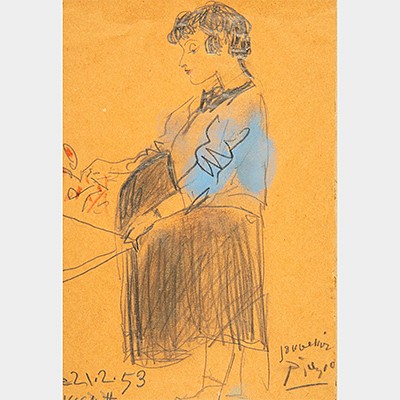EDUARDO ARROYO (Madrid, 1937-2018). "Money", 1989. Charcoal and graphite on tracing paper on cardboard adhered to paper. Mixed media on card mounted o
Lot 84
About Seller
Setdart Auction House
Carrer Aragó 346
Barcelona
Spain
Setdart Subastas was born in 2004 and is currently the first online art auction in Spain with solidity, prestige and reliability guaranteed by our more than 60,000 users. Setdart has a young, dynamic and enterprising team ready to successfully manage the purchase and sale of art works through custom...Read more
Categories
Estimate:
EUR€9,000 - EUR€10,000
$9,375 - $10,416.67
Absentee vs Live bid
Two ways to bid:
- Leave a max absentee bid and the platform will bid on your behalf up to your maximum bid during the live auction.
- Bid live during the auction and your bids will be submitted real-time to the auctioneer.
Bid Increments
| Price | Bid Increment |
|---|---|
| EUR€0 | EUR€10 |
| EUR€200 | EUR€25 |
| EUR€500 | EUR€50 |
| EUR€1,000 | EUR€100 |
| EUR€3,000 | EUR€200 |
| EUR€5,000 | EUR€500 |
| EUR€10,000 | EUR€1,000 |
| EUR€20,000 | EUR€2,000 |
| EUR€50,000 | EUR€5,000 |
About Auction
By Setdart Auction House
Sep 20, 2021
Set Reminder
2021-09-20 08:00:00
2021-09-20 08:00:00
America/New_York
Bidsquare
Bidsquare : CONTEMPORARY ART
https://www.bidsquare.com/auctions/setdart-auction-house/contemporary-art-7482
Setdart Auction House sofia@setdart.com
Setdart Auction House sofia@setdart.com
- Lot Description
EDUARDO ARROYO (Madrid, 1937-2018). "Money", 1989. Charcoal and graphite on tracing paper on cardboard adhered to paper. Mixed media on card mounted on panel (right-hand side). Signed and dated in the lower right area. It has a label on the back and has museum glass. Measurements: 96 x 105 cm; 118 x 130 cm (frame). PROVENANCE: - Collection of the artist. - Private collection, Belgium. - Aguttes S.A.S, Art Contemporain de l'après-guerre à nos jours. Neuilly-sur-Seine France, , lot 94, p. 181. - Aguttes S.A.S, Art Contemporain. Neuilly-sur-Seine France, 2020, lot 109. - Aguttes S.A.S, Art Contemporain - De l'après-guerre à nos jours. 2021, lot 99. - Private Collection, Madrid. BIBLIOGRAPHY: -Eduardo Arroyo, Territorio Íntimo, exhibition catalogue of the Fundación Cerezales, Antonino y Cinia Cerezales del Condado León, 2009. n ° 58, p. 183. EXHIBITION: -Eduardo Arroyo, Territorio Intimo, Fondation Cerezales, Antonino and Cinia Cerezales, exhibition from 22 July to 15 November 2009. Portrait of a woman in profile, in which the artist uses a whole series of symbolism associated with the concept of money, such as the shape of the dollar, which defines the eye, or the pound, which forms the nose. The lips have rounded details that may allude to some of the old Spanish coins. This is a symbolic display in which the artist associates the woman's senses, her sight, smell and taste, with money. This type of portrait in which Arroyo conceived the face of a woman through the explicit use of symbols was very common in his work at the end of the eighties, in fact, a clear example are the works he produced of Europe and Spain. A painter, sculptor and engraver, Arroyo stands out as an important figure in the neo-figurativist movement. A key figure in the new Spanish figuration, Arroyo came to prominence on the national art circuit only belatedly, from the 1980s onwards, after a two-decade period forced by the Franco regime. Today, his works hang in the most reputed Spanish museums and his creativity extends to theatrical scenographies and illustrated editions. Arroyo began his career in journalism, finishing his studies in 1957. He then left for Paris, fleeing the stifling Spanish political climate of the time. Although his first vocation was as a writer, a task he continues to pursue to this day, by 1960 he was already making a living as a painter. That year he took part for the first time in the Salon de Peinture Jeunesse in Paris. His critical attitude towards dictatorships, both political and artistic, led him to take controversial initiatives. He opted for figurative painting at a time when abstract painting was overwhelmingly dominant in Paris, and his early themes were reminiscent of "black Spain" (effigies of Philip II, bullfighters, dancers), worked in a caustic and unromantic manner. At the beginning of the 1960s his plastic vocabulary moved under the American influence of pop art, and in 1964 his break with informal art became definitive. His first public impact came in 1963, when he presented a series of effigies of dictators at the Third Paris Biennial, which provoked protests from the Spanish government. That same year, Arroyo prepared an exhibition at the Biosca gallery in Madrid, which opened without his presence as he had to flee to France, pursued by the police; the exhibition was censored and closed a few days later. However, Arroyo's figurative option was slow to be accepted in Paris. The painter rejected the unconditional devotion to certain avant-gardists, such as Duchamp or Miró, which he considered imposed by fashions. His real interest was in demystifying the great masters and defending the role of the market as a protector and thermometer of art, as opposed to the network of museums and influences paid for with public money. In 1974, Arroyo was expelled from Spain by the regime, and would not recover his passport until Franco's death.
- Shipping Info
-
In-house shipping available. Please inquire at admin@setdart.com.
-
- Buyer's Premium



 EUR
EUR CAD
CAD AUD
AUD GBP
GBP MXN
MXN HKD
HKD CNY
CNY MYR
MYR SEK
SEK SGD
SGD CHF
CHF THB
THB


















